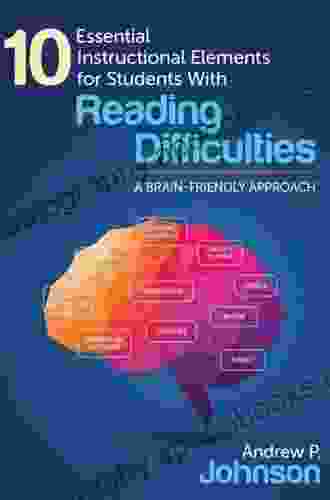Unlock Your Brain's Potential: A Brain-Friendly Approach to Learning and Productivity

In today's fast-paced world, we're constantly bombarded with information. It can be difficult to know how to learn and retain all of this information, and even more difficult to know how to use it to be productive.
4.7 out of 5
| Language | : | German |
| File size | : | 1542 KB |
| Text-to-Speech | : | Enabled |
| Enhanced typesetting | : | Enabled |
| Print length | : | 86 pages |
| Screen Reader | : | Supported |
The good news is that there is a way to learn and be productive that is both effective and enjoyable. It's called the brain-friendly approach.
What is the Brain-Friendly Approach?
The brain-friendly approach is a way of learning and working that takes into account how the brain actually works. It's based on the latest research in neuroscience, and it has been shown to be more effective than traditional methods of learning and working.
The brain-friendly approach focuses on the following principles:
- Chunking information: The brain can only process a limited amount of information at a time. So, it's important to break down information into smaller, manageable chunks.
- Spaced repetition: The brain remembers information better when it is encountered multiple times over a period of time. So, it's important to review information on a regular basis.
- Active learning: The brain learns best when it is actively engaged. So, it's important to do things like take notes, discuss information with others, and test yourself.
- Multisensory learning: The brain learns best when it is exposed to information through multiple senses. So, it's important to use a variety of learning methods, such as reading, listening, and watching videos.
- Breaks: The brain needs time to rest and consolidate information. So, it's important to take breaks throughout the day, and to get enough sleep at night.
Benefits of the Brain-Friendly Approach
The brain-friendly approach has a number of benefits, including:
- Improved learning: The brain-friendly approach has been shown to improve learning in a number of studies. For example, one study found that students who used the brain-friendly approach to learn a new language learned more words and remembered them better than students who used traditional methods of learning.
- Increased productivity: The brain-friendly approach can also help to increase productivity. By taking into account how the brain works, the brain-friendly approach can help you to stay focused, avoid distractions, and get more done in less time.
- Reduced stress: The brain-friendly approach can also help to reduce stress. By taking breaks and getting enough sleep, you can help to keep your brain healthy and functioning at its best.
How to Use the Brain-Friendly Approach
The brain-friendly approach can be used in a variety of settings, including school, work, and at home. Here are a few tips for using the brain-friendly approach:
- Break down information into smaller chunks: When you're learning something new, don't try to memorize everything at once. Instead, break it down into smaller, manageable chunks. This will make it easier for your brain to process and remember the information.
- Review information on a regular basis: Once you've learned something new, don't forget about it! Review the information on a regular basis to help your brain remember it. You can review information by reading your notes, discussing it with others, or testing yourself.
- Engage your brain actively: The brain learns best when it is actively engaged. So, when you're learning something new, don't just passively read or listen. Instead, take notes, discuss the information with others, and test yourself. This will help your brain to remember the information better.
- Use a variety of learning methods: The brain learns best when it is exposed to information through multiple senses. So, when you're learning something new, use a variety of learning methods, such as reading, listening, and watching videos. This will help your brain to remember the information better.
- Take breaks: The brain needs time to rest and consolidate information. So, it's important to take breaks throughout the day, and to get enough sleep at night. This will help your brain to function at its best.
The brain-friendly approach is a powerful way to learn and be productive. By taking into account how the brain actually works, the brain-friendly approach can help you to achieve your goals and reach your full potential.
4.7 out of 5
| Language | : | German |
| File size | : | 1542 KB |
| Text-to-Speech | : | Enabled |
| Enhanced typesetting | : | Enabled |
| Print length | : | 86 pages |
| Screen Reader | : | Supported |
Do you want to contribute by writing guest posts on this blog?
Please contact us and send us a resume of previous articles that you have written.
 Book
Book Novel
Novel Page
Page Chapter
Chapter Text
Text Story
Story Genre
Genre Reader
Reader Library
Library Paperback
Paperback E-book
E-book Magazine
Magazine Newspaper
Newspaper Paragraph
Paragraph Sentence
Sentence Bookmark
Bookmark Shelf
Shelf Glossary
Glossary Bibliography
Bibliography Foreword
Foreword Preface
Preface Synopsis
Synopsis Annotation
Annotation Footnote
Footnote Manuscript
Manuscript Scroll
Scroll Codex
Codex Tome
Tome Bestseller
Bestseller Classics
Classics Library card
Library card Narrative
Narrative Biography
Biography Autobiography
Autobiography Memoir
Memoir Reference
Reference Encyclopedia
Encyclopedia Albert M Sandler
Albert M Sandler Alan R Karls
Alan R Karls Elizabeth Barrett Browning
Elizabeth Barrett Browning Sherwin Bitsui
Sherwin Bitsui Juergen Pintaske
Juergen Pintaske Atsons
Atsons Serge Elie Seropian
Serge Elie Seropian Stephen Dinan
Stephen Dinan Alex Cain
Alex Cain Mjg Education
Mjg Education Lex Martin
Lex Martin Alexis J Levi
Alexis J Levi Donna F Brown
Donna F Brown Alanna Martin
Alanna Martin Alan Knuth
Alan Knuth Albin Zak
Albin Zak Elyn Aviva
Elyn Aviva Rebecca Hamlin
Rebecca Hamlin J Leigh Bralick
J Leigh Bralick K V Slavin
K V Slavin
Light bulbAdvertise smarter! Our strategic ad space ensures maximum exposure. Reserve your spot today!
 Andrew BellFollow ·10.5k
Andrew BellFollow ·10.5k Nathaniel PowellFollow ·7.5k
Nathaniel PowellFollow ·7.5k Jayden CoxFollow ·14.6k
Jayden CoxFollow ·14.6k Paulo CoelhoFollow ·16.1k
Paulo CoelhoFollow ·16.1k Jack ButlerFollow ·12.5k
Jack ButlerFollow ·12.5k Felix CarterFollow ·9.9k
Felix CarterFollow ·9.9k Marvin HayesFollow ·14.1k
Marvin HayesFollow ·14.1k Aldous HuxleyFollow ·11.6k
Aldous HuxleyFollow ·11.6k

 W. Somerset Maugham
W. Somerset MaughamBach Dialogue With Modernity: A Journey Through Time and...
Prelude: Bach's Timeless...

 Ted Simmons
Ted SimmonsAsher Heroes At Heart Maryann Jordan: The Essential Guide...
Are you ready to...

 Paulo Coelho
Paulo CoelhoVienna Spies: Uncover the Hidden World of Espionage in...
Vienna has long...

 Herman Melville
Herman MelvilleThe Complete Guide to Orchestral Cymbal Playing:...
Step into the vibrant...

 Rubén Darío
Rubén DaríoEscape into a Holiday Haven with California Christmas...
Embark on a heartwarming and festive journey...
4.7 out of 5
| Language | : | German |
| File size | : | 1542 KB |
| Text-to-Speech | : | Enabled |
| Enhanced typesetting | : | Enabled |
| Print length | : | 86 pages |
| Screen Reader | : | Supported |














